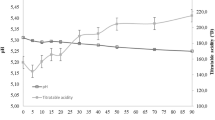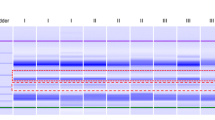Abstract
The artisanal Colonial cheese is typical of the southern region of Brazil and dates back to the colonization by Italian and German immigrants. Produced with raw milk, it is the main cheese produced by more than 15,200 small rural proprieties. The consumer increasingly appraises food with territorial valorization, demanding specific sanitary norms for this type of cheese. This work aimed to know the physical–chemical characteristics of the cheeses produced in the west of Santa Catarina State, to study the ripening time to reach microbiological safety, and to experimentally observe the survival of Salmonella enterica serovar Enteritidis ATCC 13076 during the ripening. The physical–chemical characterization was performed with 129 samples of cheeses. Five dairies were selected for evaluation of the ripening process. Salmonella survival using a challenge test was performed on three batches prepared in a pilot plant. The cheeses were classified as high (15.4%), medium (74.6%), and low moisture (9.2%), and concerning fat content as semi-fat (37.5%) and fat (62.5%). Salmonella challenge test demonstrated their survival for up to 28 days, depending on the initial contamination. The ripening monitoring showed that thermotolerant coliforms could be a good indicator of the process because they are the most persistent microorganisms.
Similar content being viewed by others
Data availability
The datasets generated during and/or analyzed during the current study are available from the corresponding author on request.
References
Carvalho MDM, De Dea Lindner J, Fariña LO (2016) A Produção de Queijo Colonial Artesanal no Município de Seara, Estado de Santa Catarina, Frente à Legislação Brasileira. Rev do Inst. Laticínios Cândido Tostes 70:253–261. https://doi.org/10.14295/2238-6416.v70i5.463
Carvalho MM, de Fariña LO, Strongin D, Ferreira CLLF, De Dea Lindner J (2019) Traditional Colonial-type cheese from the south of Brazil: a case to support the new Brazilian laws for artisanal cheese production from raw milk. J Dairy Sci 102:9711–9720. https://doi.org/10.3168/jds.2019-16373
Lei B (2019) N° 13.860, de 18 de Julho de 2019. Dispõe sobre a Elaboração e a Comercialização de Queijos Artesanais e dá outras Providências. Diário Of da União
SantaCatarina Lei N° 17.486, de 16 de Janeiro de 2018. Dispõe sobre a Produção e Comercialização de Queijos Artesanais de Leite Cru e Adota outras Providências. Diário Of do Estado St Catarina 2018
Paraná Lei No 19.599 de 17/07/2018. Dispõe sobre a Produção e a Comercialização dos Queijos Artesanais no Estado do Paraná. Diário Of do Estado do Paraná 2018
Rio Grande do Sul Lei No 15615 de 13/05/2021. Dispõe sobre a Produção e a Comercialização de Queijos Artesanais de Leite Cru e dá outras Providências. Diário Of do Estado do Rio Gd do Sul 2021
Rocha DCC, Marinho ANR, Reis MSO, Borges IR, Ramos FLP, Loureiro ECB (2014) Perfil Epidemiológico e Caracterização Molecular de Salmonella Typhi Isoladas No Estado Do Pará, Brasil. Rev Pan-Amazônica Saúde 5:53–62. https://doi.org/10.5123/s2176-62232014000400007
Martins JM, Galinari É, Pimentel-filho NJ, Ribeiro JI Jr, Furtado MM, Ferreira CLLF (2015) Determining the minimum ripening time of artisanal Minas cheese, a traditional Brazilian cheese. Brazilian J Microbiol 46:219–230. https://doi.org/10.1590/S1517-838246120131003
Dores MT, Nobrega JE, Ferreira CLLF (2013) Room temperature aging to guarantee microbiological safety of Brazilian artisan Canastra cheese. Food Sci Technol 33:180–185. https://doi.org/10.1590/S0101-20612013005000003
Lutz A (2008) Métodos Físico-Químicos para Análise de Alimentos. Instituto Adolfo Lutz, São Paulo, Brazil
Brasil (1999) Métodos Analíticos Oficiais para Controle de Produtos de Origem Animal e seus Ingredientes. In: Ministério Da Agricultura, Secretaria Nacional de Defesa Agropecuária, Laboratório Nacional de Referência Animal, Brasilia, Distrito Federal, Brazil
Kindstedt PS (2005) American farmstead cheese: the complete guide to making and selling artisan cheeses. Vermont Cheese Council, Waitsfield, United States
Brasil (2022) Métodos Oficiais Para Análise de Produtos de Origem Animal. In: Ministério da Agricultura, Secretaria Nacional de Defesa Agropecuária, Laboratório Nacional de Referência Animal, Brasilia, Distrito Federal, Brazil
Krispien K, Rödel W, Leistener L (1979) Vorschlag Zur Berechnun Der Wasseraktivität (Aw-Wert) von Fleischerzeugnissen Aus Den Gehalten von Wasser Und Kochsals. Die Fleischwirtschaft 59:1173–1177 Germany
Brasil (1996) Portaria No 146, de 7 de Março de 1996. Aprova os Regulamentos Técnicos de Identidade e Qualidade dos Produtos Lácteos. Ministério Da Agricultura, Pecuária e Abastecimento – MAPA. Diário Of. da União 1996
Louvatel K, Degenhardt R (2016) Caracterização Bromatológica de Queijos Coloniais Produzidos no Distrito de Santa Lúcia, Município de Ouro, SC. Jorn Integr Biol 3:37–46. https://periodicos.unoesc.edu.br/jornadaintegradaembiologia/article/view/10306
Santa Catarina (2021) Lei No 18.250, de 10 de Novembro de 2021. Dispõe Sobre os Requisitos Exigidos para Elaboração do Regulamento Técnico de Identidade e Qualidade do Queijo Colonial Artesanal de Leite Cru e Adota Outras Providências. Diário Of. do Estado St. Catarina 2021
Callon C, Retureau E, Didienne R, Montel MC (2014) Microbial biodiversity in cheese consortia and comparative Listeria growth on surfaces of uncooked pressed cheeses. Int J Food Microbiol 174:98–109. https://doi.org/10.1016/j.ijfoodmicro.2014.01.003
Hargrove RE, McDonough FE, Mattingly WA (1969) Factors affecting survival of Salmonella in Cheddar and Colby cheese. J Milk Food Technol 32(12):480–484. https://doi.org/10.4315/0022-2747-32.12.480
White CH, Custer EW (1976) Survival of Salmonella in Cheddar cheese. J Milk Food Technol 39(5):328–331. https://doi.org/10.4315/0022-2747-39.5.328
Borges MDF, Brandão SCC, Pinheiro AJR (1990) Sobrevivência de Salmonella em Queijo Minas Padronizado Durante a Maturação. Rev Microbiol 21(3):276–281
Lobacz A, Kowalik J, Zulewska J (2020) Determination of the survival kinetics of Salmonella spp. on the surface of ripened raw milk cheese during storage at different temperatures. Int J Food Sci Technol 55:610–618. https://doi.org/10.1111/ijfs.14315
Shrestha S, Grieder JA, McMahon DJ, Nummer BA (2011) Survival of Salmonella serovars introduced as a post-aging contaminant during storage of low-salt Cheddar cheese at 4, 10, and 21 °C. J Food Sci 76(9):M592–M599. https://doi.org/10.1111/j.1750-3841.2011.02430.x
Acknowledgements
The authors would like to thank the Associação dos Pequenos Agricultores do Oeste Catarinense (APACO), Cooperativa de Crédito Rural de Seara (CREDISEARA), the group of informal producers of Seara, and the entire group of collaborators involved in this cause, for the support and assistance provided during the realization of this study.
Author information
Authors and Affiliations
Contributions
RD and JDDL contributed to the study conception and design. RD, MFV, GFD, and AG performed laboratory analyses. RD carried out statistical analyses. RD, MFV, GFD, and AG collected the data and prepared the manuscript, under the supervision of JDDL. All authors edited, read, and approved the final manuscript.
Corresponding author
Ethics declarations
Consent for publication
All authors have contributed to the work and have agreed to submit the manuscript.
Conflict of interest
The authors declare no competing interests.
Additional information
Responsible Editor: Elaine Cristina Pereira de Martinis
Publisher’s note
Springer Nature remains neutral with regard to jurisdictional claims in published maps and institutional affiliations.
Rights and permissions
Springer Nature or its licensor (e.g. a society or other partner) holds exclusive rights to this article under a publishing agreement with the author(s) or other rightsholder(s); author self-archiving of the accepted manuscript version of this article is solely governed by the terms of such publishing agreement and applicable law.
About this article
Cite this article
Degenhardt, R., Carvalho, M.M., Voidaleski, M.F. et al. Brazilian artisanal Colonial cheese: characterization, microbiological safety, and survival of Salmonella enterica serovar Enteritidis during ripening. Braz J Microbiol 54, 2129–2135 (2023). https://doi.org/10.1007/s42770-023-01022-1
Received:
Accepted:
Published:
Issue Date:
DOI: https://doi.org/10.1007/s42770-023-01022-1




